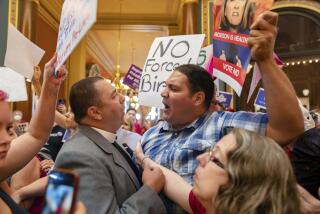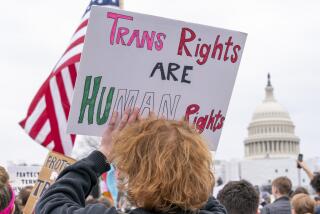No Ruling Yet on Key Abortion Case : Monday Is Last Day of This Term That Court Can Issue Decision
- Share via
WASHINGTON — The Supreme Court did not do what it had been expected to do Thursday--issue a ruling in the most closely watched abortion case in a decade.
Instead, after a 10-minute session, Chief Justice William H. Rehnquist announced that the court will meet Monday and issue “all the remaining opinions ready during the term of the court.”
That means, court officials said, that Monday will be the last day for decisions in the 1988-89 court term. But it does not necessarily mean that a ruling on the abortion case will be released then. The justices could choose to put off making a decision and hear the case again in October.
Also awaiting decision is an important religion case, testing whether a city unconstitutionally promotes religion by placing a Nativity scene in its city hall during the Christmas season.
Why is the abortion ruling taking so long? No one who knew the answer was talking. But that did nothing to dampen speculation.
One theory held that the five conservative justices--those who are most likely to uphold states’ rights to limit abortions--may be having a difficult time writing a majority opinion. The Supreme Court is a committee, and many committees have a notoriously tough time writing anything.
Attention focused also on Justice Sandra Day O’Connor’s frequent indecisiveness. In the court’s last term, she agonized for seven months before casting the key vote to spare the life of a 15-year-old. Now, as the most moderate of the court’s five conservatives on the abortion issue, she is thought to hold the deciding vote in this case also.
Another possibility is that the liberal dissenters may have wanted more time to dissect the majority’s conclusion.
Or the explanation for the delay could be entirely mundane. The court’s print shop might have been unable on short notice to print enough copies of a thick opinion for release at 10 a.m. Thursday.
The case (Webster vs. Reproductive Health Services) is an appeal by the Missouri attorney general of a lower court order overturning regulations forbidding the use of public facilities or employees to assist or encourage abortions. The Bush Administration, intervening in the case, urged the justices to go much further and overrule the landmark Roe vs. Wade ruling that made abortion legal in the nation.
The Supreme Court, unlike most Washington institutions, is famous for its ability to keep secrets, and no hint has come from the court of what its decision will be or even when it might be issued. “The fact is, we never know what (decision) is coming down,” Kathy Arberg, a court spokeswoman, said.
This week, which court observers had thought would be the last of the term, the court said that it would release decisions on Monday and Thursday. When the abortion decision was not announced Monday, Thursday looked like the day.
By dawn, spectators had lined up for the few seats in the courtroom. Scores of cameras and microphones were ready outside on the marble plaza to record the remarks of the anti-abortion activists and those who want to preserve the right to abortion.
On a typical decision day, about a dozen reporters go upstairs to the courtroom to hear the decisions read. Another dozen or so, mostly wire service and broadcast reporters, stay in the press room downstairs so that they can quickly pick up the written decisions and announce them.
On Thursday, more than 100 reporters jammed into the small press room downstairs while 50 were given passes to go upstairs to hear the opinions read.
They heard Justice Antonin Scalia read an opinion concerning what are “popularly known as Tupperware parties.” The issue was whether a state university may prevent vendors and business persons from selling products or making presentations in dormitories. School officials said that they wanted to preserve an educational environment on campus and prevent the exploitation of students.
Several students sued, contending that the rule violated the First Amendment’s free speech clause. A judge dismissed the suit, but an appeals court in New York ordered a trial. It said that a government body such as a state university may not restrict “commercial speech” unless it has a compelling reason for doing so and its regulation is the “least restrictive” means of accomplishing its end.
Scalia, speaking for a 6-3 majority, disagreed. He said that the university’s regulation must only be a “reasonable” means of accomplishing its goal. “We leave it to governmental decision makers to judge what manner of regulation may best be employed,” he said.
The ruling (SUNY vs. Fox, 87-2013) may indicate that the court is going to give less protection to “commercial speech.” Beginning in the 1970s, the high court brought “commercial speech” under the protection of the First Amendment, but Rehnquist has steadily opposed that idea and argued that the government may ban advertising for products such as cigarettes.
After Scalia finished, Justices John Paul Stevens and Byron R. White read parts of their opinions on whether Indians may use zoning laws to regulate reservation land that is owned by non-Indians (Brendale vs. Confederated Tribes, 87-1622). The answer was no.
With that, Rehnquist adjourned the court until Monday.
More to Read
Get the L.A. Times Politics newsletter
Deeply reported insights into legislation, politics and policy from Sacramento, Washington and beyond. In your inbox twice per week.
You may occasionally receive promotional content from the Los Angeles Times.











